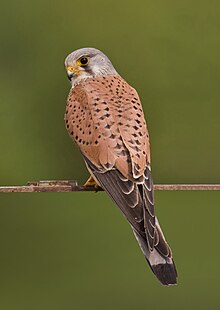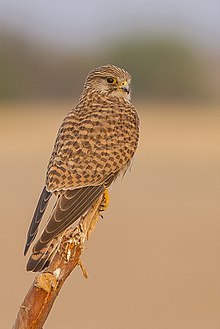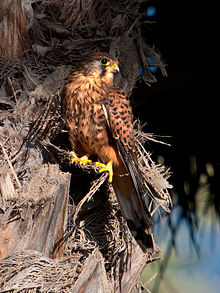Common kestrel
| Common kestrel | |
|---|---|

| |
| Adult male Falco tinnunculus tinnunculus | |

| |
| Adult Female Falco tinnunculus tinnunculus from Tal Chhapar Sanctuary, Churu, Rajasthan, India | |
| Scientific classification | |
| Domain: | Eukaryota |
| Kingdom: | Animalia |
| Phylum: | Chordata |
| Class: | Aves |
| Order: | Falconiformes |
| Family: | Falconidae |
| Genus: | Falco |
| Species: | F. tinnunculus
|
| Binomial name | |
| Falco tinnunculus | |
| Subspecies | |
|
About 10, see text | |

| |
| Global map of eBird reports of F. t. tinnunculus Year-Round Range Summer Range Winter Range
| |
| Synonyms | |
|
Falco rupicolus | |
The common kestrel (Falco tinnunculus) is a bird of prey species belonging to the kestrel group of the falcon family Falconidae. It is also known as the European kestrel, Eurasian kestrel, or Old World kestrel. In the United Kingdom, where no other kestrel species commonly occurs, it is generally just called "kestrel".[2]
This species occurs over a large range. It is widespread in
Taxonomy
The common kestrel was
This species is part of a
The rock kestrel (F. rupicolus), previously considered a subspecies, is now treated as a distinct species.[18] The lesser kestrel (F. naumanni), which much resembles a small common kestrel with no black on the upperside except wing and tail tips, is probably not very closely related to the present species, and the American kestrel (F. sparverius) is apparently not a true kestrel at all.[16] Both species have much grey in their wings in males, which does not occur in the common kestrel or its close living relatives but does in almost all other falcons.
Subspecies


Eleven subspecies are recognised.[18] Most differ little, and mainly in accordance with Bergmann's and Gloger's rules. Tropical African forms have less grey in the male plumage.[4]
- F. t. tinnunculus Linnaeus, 1758 – Himalaya mountain ranges to the NW Sea of Okhotsk region. Northern Asian populations migratesouth in winter, apparently not crossing the Himalayas but diverting to the west.
- F. t. perpallidus (Clark, AH, 1907) – northeast Siberia to northeast China and Korea Peninsula
- F. t. interstinctus Indochina. Winters to the south of its breeding range, from northeastern India to the Philippines (where it is localized, e.g. from Mindanao only two records exist). Has dark heavily marked birds and has a foxed red phase but not reliably identified in the field.[19][20]
- F. t. objurgatus (Nilgiris and Eastern Ghats of India; Sri Lanka. Heavily marked, has rufous thighs with dark grey head in males.[20][21]
- F. t. canariensis (Koenig, 1890) – Madeira and western Canary Islands
- F. t. dacotiae Hartert, EJO, 1913 – eastern Canary Islands: Fuerteventura, Lanzarote, Chinijo Archipelago.
- F. t. neglectus Cape Verde Islands
- F. t. alexandri Bourne, 1955 – southwestern Cape Verde Islands.
- F. t. rupicolaeformis (Brehm, CL, 1855) – Arabian Peninsula except in the desert and across the Red Sea into Africa
- F. t. archerii (Hartert, EJO & Neumann, 1932) – Somalia, coastal Kenya, and Socotra
- F. t. rufescens .
The common kestrels of Europe living during cold periods of the
Description
The common kestrels measures 32–39 cm (12+1⁄2–15+1⁄2 in) from head to tail, with a wingspan of 65–82 cm (25+1⁄2–32+1⁄2 in). The females is noticeably larger, with the adult male weighing 136–252 g (4+3⁄4–8+7⁄8 oz), around 155 g (5+1⁄2 oz) on average; the adult female weighs 154–314 g (5+3⁄8–11+1⁄8 oz), around 184 g (6+1⁄2 oz) on average. They are thus small compared with other birds of prey, but larger than most songbirds. Like the other Falco species, they have long wings as well as a distinctive long tail.[4]
The plumage is mainly light
The
Behaviour and ecology
In the cool-
Globally, this species is not considered threatened by the
Food and feeding


When hunting, the common kestrel characteristically hovers about 10–20 m (35–65 ft) above the ground, searching for prey, either by flying into the wind or by soaring using

They eat almost exclusively mouse-sized
The common kestrel requires the equivalent of 4–8 voles a day, depending on energy expenditure (time of the year, amount of hovering, etc.). They have been known to catch several voles in succession and cache some for later consumption. An individual nestling consumes on average 4.2 g/h, equivalent to 67.8 g/d (3–4 voles per day).[28]
Breeding


The common kestrel starts breeding in spring (or the start of the
The clutch is normally 3–7 eggs; more eggs may be laid in total but some will be removed during the laying time. This lasts about 2 days per egg laid. The eggs are abundantly patterned with brown spots, from a wash that tinges the entire surface buffish white to large almost-black blotches. Incubation lasts from 4 weeks to one month, both male and female will take shifts incubating the eggs. After the eggs have hatched, the parents share brooding and hunting duties. Only the female feeds the chicks, by tearing apart prey into manageable chunks. The young fledge after 4–5 weeks. The family stays close together for a few weeks, during which time the young learn how to fend for themselves and hunt prey. The young become sexually mature the next breeding season.[4] Female kestrel chicks with blacker plumage have been found to have bolder personalities, indicating that even in juvenile birds plumage coloration can act as a status signal.[30]
Data from Britain shows nesting pairs bringing up about 2–3 chicks on average, though this includes a considerable rate of total brood failures; actually, few pairs that do manage to fledge offspring raise less than 3 or 4. Compared to their siblings, first-hatched chicks have greater survival and recruitment probability, thought to be due to the first-hatched chicks obtaining a higher body condition when in the nest.[31] Population cycles of prey, particularly voles, have a considerable influence on breeding success. Most common kestrels die before they reach 2 years of age; mortality up until the first birthday may be as high as 70%. At least females generally breed at one year of age;[32] possibly, some males take a year longer to maturity as they do in related species. The biological lifespan to death from senescence can be 16 years or more, however; one was recorded to have lived almost 24 years.[32]
-
Hatchling of common kestrel (note whitedown)
-
Fledglings in nest cavity
-
Immature after fledging
-
Common kestrel nest
In culture

The kestrel is sometimes seen, like other birds of prey, as a symbol of the power and vitality of nature. In "Into Battle" (1915), the war poet Julian Grenfell invokes the superhuman characteristics of the kestrel among several birds, when hoping for prowess in battle:
The kestrel hovering by day,
And the little owl that call at night,
Bid him be swift and keen as they,
As keen of ear, as swift of sight.
Gerard Manley Hopkins (1844–1889) writes on the kestrel in his poem "The Windhover", exalting in their mastery of flight and their majesty in the sky.
I caught this morning morning's minion, king-
dom of daylight's dauphin, dapple-dawn-drawn Falcon, in his riding
A kestrel is also one of the main characters in
Barry Hines’ novel A Kestrel for a Knave - together with the 1969 film based on it, Ken Loach's Kes - is about a working-class boy in England who befriends a kestrel.
The Pathan name for the kestrel, Bād Khurak, means "wind hover" and in Punjab it is called Larzānak or "little hoverer". It was once used as a decoy to capture other birds of prey in Persia and Arabia. It was also used to train greyhounds meant for hunting gazelles in parts of Arabia. Young greyhounds would be set after jerboa-rats which would also be distracted and forced to make twists and turns by the dives of a kestrel.[33]
References
- ^ . Retrieved 12 November 2021.
- ^ Mangoverde World Bird Guide 2009
- ^ "Common Kestrels | Beauty of Birds". www.beautyofbirds.com. Retrieved 2021-01-05.
- ^ a b c d e f g h i j k Orta 1994
- ^ Wiles et al. 2000
- ^ a b Wiles et al. 2004
- ^ Linnaeus, Carl (1758). Systema Naturae per regna tria naturae, secundum classes, ordines, genera, species, cum characteribus, differentiis, synonymis, locis (in Latin). Vol. 1 (10th ed.). Holmiae (Stockholm): Laurentii Salvii. p. 90.
- ^ Linnaeus, Carl (1761). Fauna svecica, sistens animalia sveciae regni mammalia, aves amphibia, pisces, insecta, vermes (in Latin) (2nd ed.). Stockholmiae: Sumtu & Literis Direct. Laurentii Salvii. p. 21.
- ^ Mayr, Ernst; Cottrell, G. William, eds. (1979). Check-List of Birds of the World. Vol. 1 (2nd ed.). Cambridge, Massachusetts: Museum of Comparative Zoology. p. 405.
- ISBN 978-0199206872.
- ISBN 978-1-4081-2501-4.
- ^ Gesner, Conrad (1555). Historiae animalium liber III qui est de auium natura. Adiecti sunt ab initio indices alphabetici decem super nominibus auium in totidem linguis diuersis: & ante illos enumeratio auium eo ordiné quo in hoc volumine continentur (in Latin). Zurich: Froschauer. pp. 53–55.
- ^ a b "kestrel". Oxford English Dictionary (Online ed.). Oxford University Press. (Subscription or participating institution membership required.)
- ^ Weekley 1921
- ^ Possibly to be reclassified as Early Pleistocene.
- ^ a b See Groombridge et al. 2002 for a thorough discussion of common kestrel and relatives' divergence times.
- .
- ^ Rasmussen, Pamela, eds. (December 2023). "Seriemas, falcons". IOC World Bird List Version 14.1. International Ornithologists' Union. Retrieved 10 February 2024.
- ^ Peterson et al. 2008
- ^ a b Rasmussen & Anderton 2005
- ^ Whistler 1949, pp. 385–387
- ^ Mlíkovský 2002, pp. 222–223
- ^ Mourer-Chauviré et al. 2003
- ^ Inskipp, Inskipp & Sherub 2000
- ^ Viitala et al. 1995
- ^ Mikula, Hromada & Tryjanowski 2013
- ^ Steen, Løw & Sonerud 2011a
- ^ Steen et al. 2011b
- ^ Álamo Tavío 1975
- S2CID 91263096.
- .
- ^ a b AnAge 2010
- ^ Phillott, D.C. (1832). "Note on the Common Kestril (Tinnunculus alaudarius)". Journal of the Asiatic Society of Bengal. 2 (10): 527–528.
Sources
- Álamo Tavío, Manuel (1975). Asociación Canaria para Defensa de la Naturaleza (ed.). "Aves de Fuerteventura en peligro de extinción" [Birds of Fuerteventura threatened with extinction]. Aves y Plantas de Fuerteventura en Peligro de Extinción (in Spanish): 10–32.
- "Falco tinnunculus life history data". AnAge. 2010. Archived from the original on 2 March 2012. Retrieved 1 August 2010.
- Groombridge, Jim J.; PMID 12414309. Archived from the original(PDF) on 2007-09-14.
- Inskipp, Carol; Inskipp, Tim; Sherub (2000). "The ornithological importance of Thrumshingla National Park, Bhutan" (PDF). Forktail. 14: 147–162. Archived from the original (PDF) on 2014-08-10. Retrieved 2015-04-17.
- "Eurasian Kestrel Falco tinnunculus". mangoverde.com. Mangoverde World Bird Guide (MWBG). 2009. Archived from the original on 7 December 2008. Retrieved 2 January 2009.
- Mikula, P.; Hromada, M.; Tryjanowski, P. (2013). "Bats and Swifts as food of the European Kestrel (Falco tinnunculus) in a small town, in Slovakia" (PDF). Ornis Fennica. 3: 178–185. Archived from the original (PDF) on 2016-12-03. Retrieved 2015-04-17.
- Mlíkovský, Jiří (2002). Cenozoic Birds of the World (Part 1: Europe) (PDF). Prague: Ninox Press. Archived from the original (PDF) on 2011-05-20. Retrieved 2018-12-12. ISBN 80-901105-3-8
- Mourer-Chauviré, C.; Philippe, M.; Quinif, Y.; Chaline, J.; Debard, E.; Guérin, C.; Hugueney, M. (2003). "Position of the palaeontological site Aven I des Abîmes de La Fage, at Noailles (Corrèze, France), in the European Pleistocene chronology". Boreas. 32 (3): 521–531. S2CID 129833747.
- Orta, Jaume (1994). "Common Kestrel". In del Hoyo, Josep; Elliott, Andrew; Sargatal, Jordi (eds.). Handbook of Birds of the World. Vol. 2 (New World vultures to Guineafowl). Barcelona: Lynx Edicions. pp. 259–260, plates 26. ISBN 978-84-87334-15-3.
- Peterson, A. Townsend; Brooks, Thomas; Gamauf, Anita; Gonzalez, Juan Carlos T.; Mallari, Neil Aldrin D.; Dutson, Guy; Bush, Sarah E.; Fernandez, Renato (2008). "The Avifauna of Mt. Kitanglad, Bukidnon Province, Mindanao, Philippines" (PDF). S2CID 31061087. Archived from the original(PDF) on 2009-09-02. Retrieved 2009-05-11.
- Anderton, John C.(2005). Birds of South Asia. The Ripley Guide. Vol. 2. Washington DC and Barcelona: Smithsonian Institution and Lynx Edicions. pp. 112–113.
- Steen, R.; Løw, L.M.; Sonerud, T. (2011a). "Delivery of Common Lizards (Zootoca Lacerta vivipara) to nests of Eurasian Kestrels (Falco tinnunculus) determined by solar height and ambient temperature". Canadian Journal of Zoology. 89 (3): 199–205. S2CID 67822269.
- Steen, R.; Løw, L.M.; Sonerud, G.A.; Selås, V.; Slagsvold, T. (2011b). "Prey delivery rates as estimates of prey consumption by Eurasian Kestrel (Falco tinnunculus)". Ardea. 99: 1–8. S2CID 84472078.
- Viitala, Jussi; Korpimäki, Erkki; Palokangas, Päivi; Koivula, Minna (1995). "Attraction of kestrels to vole scent marks visible in ultraviolet light". S2CID 4356193.
- Weekley, Ernest (1921). An etymological dictionary of modern English. London: John Murray. p. 801.
- Whistler, Hugh (1949). Popular handbook of Indian birds (4th ed.). London: Gurney and Jackson.
- Wiles, Gary J.; Worthington, David J.; Beck, Robert E. Jr.; Pratt, H. Douglas; Aguon, Celestino F.; Pyle, Robert L. (2000). "Noteworthy bird records for Micronesia, with a summary of raptor sightings in the Mariana Islands, 1988-1999". Micronesica. 32 (2): 257–284. CiteSeerX 10.1.1.393.1140.
- Wiles, Gary J.; Johnson, Nathan C.; de Cruz, Justine B.; Dutson, Guy; Camacho, Vicente A.; Kepler, Angela Kay; Vice, Daniel S.; Garrett, Kimball L.; Kessler, Curt C.; Pratt, H. Douglas (2004). "New and Noteworthy Bird Records for Micronesia, 1986–2003". Micronesica. 37 (1): 69–96.
External links
- Rock kestrel species text in The Atlas of Southern African Birds
- Common kestrel media from ARKive
- "Common kestrel". Avibase.
- Common kestrel page at Israel Birding Portal
- Kestrel Bird Guide at The Royal Society for the Protection of Birds
- Text of the Hopkins poem mentioned in the article
- Kestrel on-line 2013: Brest, Belarus
- Kestrel on-line 2012: Groningen, The Netherlands Archived 2013-11-27 at the Wayback Machine
- Live Streaming of common kestrel nest in Amadora, Portugal
- Ageing and sexing (PDF; 5.5 MB) by Javier Blasco-Zumeta & Gerd-Michael Heinze
- Feathers of common kestrel (Falco tinnunculus) Archived 2013-11-03 at the Wayback Machine
- "Common kestrel media". Internet Bird Collection.
- Eurasian kestrel photo gallery at VIREO (Drexel University)
- Interactive range map of Falco tinnunculus at IUCN Red List maps





